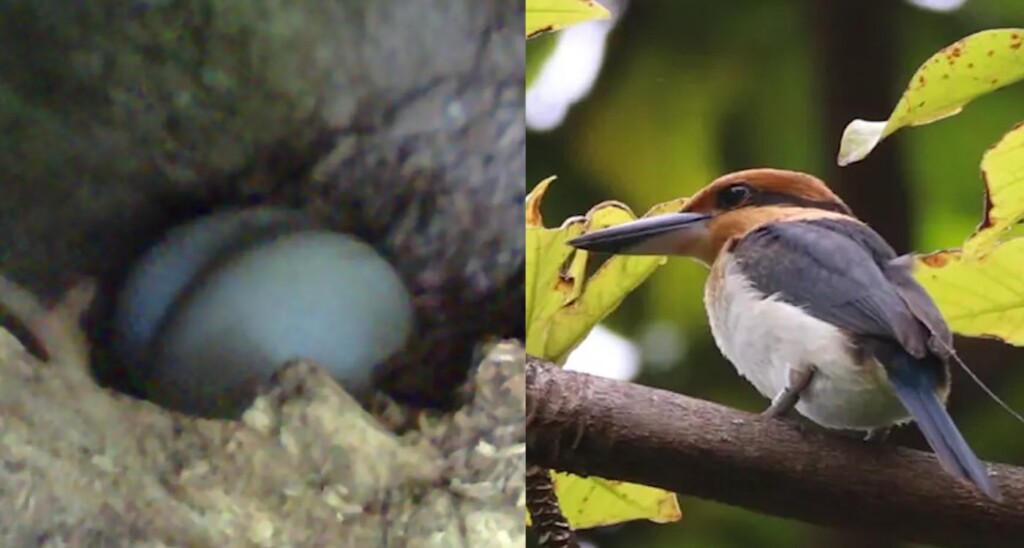 First confirmed wild-laid sihek eggs in almost 40 years © Martin Kastner TNC-ZSL
First confirmed wild-laid sihek eggs in almost 40 years © Martin Kastner TNC-ZSLIn an unprecedented success for conservation efforts, a tiny population of Guam kingfishers given a new home has laid its first eggs—after 40 years of the species being extinct in the wild.
Exterminated from its Guam island home by invasive brown tree snakes, the kingfisher, known by Guam locals as a ‘sihek’, has survived entirely in captivity, managed by a global collaboration of conservationists called the Shiek Recovery Program.
The program introduced the birds to the Palmyra Atoll thousands of miles from Guam in order to create a wild-born population that can regain natural skills until their native island has been cleared of the invasive reptile—and the sihek can return to its ancestral home.
GNN reported in September of 2022 that 20 sihek eggs were set to be transferred to Hawaii to be born in an aviary with conditions and flora similar to that of Palmyra Atoll.
The journey to recovery would be long, complex, and in some ways unprecedented. In order to reduce the risk of foreign germs or parasites spreading to atoll, the resulting sihek chicks were going to be hand-reared until 9 of them could be transferred in cages to Palmyra.
After getting their “ticket to ride” by the vet traveling with them, they would finally be able to return to the wilderness. But the program teams didn’t know which of the available prey species the sihek will favor, didn’t know what time of year, considering the 365-day perfect temperatures, the birds will breed, or how far they would disperse.
But despite the miles and the unknowns, their remarkable release last autumn was a success by any reasonable metric. Four female and five male birds quickly explored their new home, learning how to forage and hunt new prey within the tropical forest.
Four pairs have since established territories, built nests, and laid eggs, marking the first time the species has bred in the wild since its extinction from Guam in the 1980s.
“Many of us spent this Easter weekend out searching high and low for eggs of a different variety—and while they might not be as shiny or brightly colored, these tiny, unassuming-looking eggs are far more exciting and precious than any of their chocolate counterparts,” said Professor John Ewen, from the Zoological Society of London and Team Chair of the Sihek Recovery Program.
“They are a remarkable milestone for the decades-long mission to rescue the sihek from the edge of extinction, and this moment for celebration is a real testament to all the dedicated work from everyone working around the clock to protect and recover this incredible bird.”
CHECK OUT: We Finally Rid An Island of 300,000 Rats – Now Everything is Blooming
With the mated pairs less than a year old, this is their first time incubating and caring for eggs, meaning it’s likely it will take a few rounds of egg laying for the birds to hone their skills and hatch chicks, a statement from ZSL read. Nonetheless, these eggs demonstrate both the tremendous resilience of these remarkable birds and the power of conservation to create a second chance for species on the brink of extinction.
“After many long days last year looking after these birds when they were just tiny eggs and chicks, it’s so rewarding to see them beginning their journey towards raising their own chicks in the forests of Palmyra Atoll,” Charlotte James, one of the London Zoo bird keepers who hand-reared the birds.
“It’s hard not to feel like a proud parent seeing them out there thriving and making history—and an honor to be part of the ongoing mission to bring sihek back from the brink of extinction.”
MORE REMARKABLE AVIAN REVERSALS: Hawaiian Crow That Went Extinct in the Wild Decades Ago Now Released on Maui
Plans are underway for more young sihek to be released at Palmyra Atoll this summer. Egg laying season is underway at participating (Association of Zoos and Aquariums) AZA-accredited institutions across the US. As they grow to maturity, these chicks will also journey to Palmyra, with the ultimate goal of establishing ten breeding pairs there. The wild sihek at Palmyra Atoll will pave the way for a growing, wild sihek population for the first time in decades.
Then maybe, just maybe, at some point in the distant future, the descendants of these birds who’ve regained their wild skills will be able to practice them on the island of their origin once again.
SHARE This Outstanding Conservation Success On Behalf Of A Beautiful Bird…
Source link

